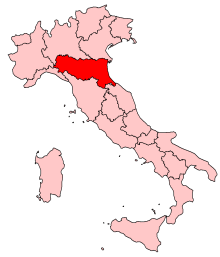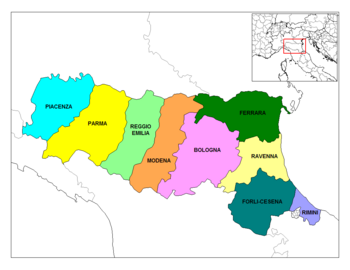Emilia-Romagna
| Emilia-Romagna | |||
| Flag | Coat of arms | ||
|
|||
| Location | |||
 |
|||
| Time zone | CET/CEST (UTC+1/+2) | ||
| Administration | |||
| Country | Italy | ||
| NUTS Region | ITD | ||
| Capital | Bologna | ||
| President | Vasco Errani (Democratic Party) | ||
| Basic statistics | |||
| Area | 22,124 km² (8,542 sq mi) (Ranked 5th, 7.3 %) |
||
| Population | 4,275,802 (12/2007) (Ranked 6th, 7.2 %) |
||
| - Density | 193 /km² (501 /sq mi) | ||
| Other information | |||
| GDP/ Nominal | € 128.8 billion (2006) | ||
| Website | www.regione.emilia-romagna.it | ||
Emilia-Romagna is one of the 20 Regions of Italy. The capital is Bologna. It has an area of 20,124 km² and about 4.2 million inhabitants.
Contents |
Geography
Emilia-Romagna is an administrative region of Northern Italy comprising the two historic regions of Emilia and Romagna. It forms a rough triangle, bounded on the East by the Adriatic Sea, on the North by the Po river and on the South by the Apennine range; these two linear features, with the Via Aemilia, and the A1 highway and the railway that run close and parallel to it, give an unusually regular structure to the whole region except for the easternmost part. About a half of the region is constituted by Padan Plain, an extremely fertile alluvial plain crossed by the river Po. The rest of the territory is occupied by the hills and mountains of Tuscan-Emilian Apennines.
Emilia-Romagna is divided into nine provinces:

- Bologna
- Ferrara
- Forlì-Cesena
- Modena
- Parma
- Piacenza
- Ravenna
- Reggio Emilia
- Rimini
History
The name Emilia-Romagna has roots in the Ancient Rome legacy in these lands. Emilia refers to via Æmilia, an important Roman way connecting Rome to the northern part of Italy. Romagna is a corruption of Romània; when Ravenna was the capital of the Italian portion of the Byzantine Empire, the Lombards extended the official name of the Empire to the lands around Ravenna. Emilia-Romagna was part of the Etruscan world and in following was passed on to the Gauls and then the Romans, who built it the Aemilian Way, for which the region was named. The coastal area of Emilia, which was ruled under the Byzantines from 540 to 751, became known as the separate region of Romagna. In the Middle Ages, the history of both Emilia and Romagna was the history of its individual cities. In the 16th century, most of these were included into the Papal States, but the territory of Parma, Piacenza, and Modena remained independent until Emilia-Romagna was included into the Italian kingdom in 1859-1861.
Economy
Emilia Romagna is considered as one of the richest European regions by GDP per capita and lowest unemployment rate of 2.9% which corresponds to full occupation regime. According to the statistics of Unioncamera, Bologna and Modena are third and fourth richest Italian cities after Milano and Biella. Bologna was also classified as the city with highest living standards in Italy for 2007. According to Eurostat, Emilia Romagna is 23rd for GDP per capita and third in Italy after the province of Bolzano-Bozen and Lombardy. Agriculture is a very important economic activity: cereals, potatoes, maize, tomatoes and onions are the most important, along with fruit and grapes for the production of wine (of which the most famous are perhaps Lambrusco, Sangiovese, Pignoletto and Albana). Cattle and hog breeding are also highly developed.

The industry of Emilia-Romagna is also healthy, especially the food industry (e.g.Barilla Group), particularly concentrated in Parma and Bologna, mechanical and automotive (e.g., Ferrari, Ducati, Lamborghini, Maserati Pagani), ceramic, concentrated in Faenza and Sassuolo, and tourism especially along the Adriatic coastline. Today the tertiary sector is bearing, with a strong concentration of insurance companies and banks. The region is also characterised by a unique economic attitude: its tens of thousands of cooperatives. In Emilia-Romagna, two out of three people belong to a co-op. Bologna alone hosts 8,000, including the one-million member left-wing Legacoop and the 250,000-strong Catholic Confcooperative. The nature of the region's economy is considered responsible for the high standard of living enjoyed by the inhabitants.[1]
Politics
Emilia-Romagna, except the province of Piacenza, was historically a stronghold of the Italian Communist Party, and now is a stronghold of center-left coalitions, forming with Tuscany, Umbria and Marche the famous Italian political "Red Quadrilateral". Probably this is because of a strong tradition of anti-clericalism dating from the 19th century, when part of Emilia-Romagna belonged of the Papal States (mostly Romagna and Bologna, in Emilia there were two independent states). At the April 2006 elections, Emilia-Romagna gave about 60% of its votes to Romano Prodi.
Demographics
The population of this region is traditionally well distributed, so do not exist a real dominant metropolis but an axis of medium size cities along the Via Emilia, where is concentrated the majority of regional industrial production. In the Appennine Mountains and in the agricultural plains around Ferrara and Piacenza the population is less dense because of the lower stage of economic development.

As of 2006, the Italian national institute of statistics (ISTAT) estimated that 288,844 foreign-born immigrants lived in Emilia-Romagna, equal to 6.8% of the total regional population.
Towns of Emilia-Romagna with a population of 50,000 or more:
| Comune | Population (2006 est.) |
|---|---|
| Bologna | 374,425 |
| Modena | 180,638 |
| Parma | 177,069 |
| Reggio Emilia | 167,013 |
| Ravenna | 149,084 |
| Rimini | 138,060 |
| Ferrara | 131,907 |
| Forlì | 112,477 |
| Piacenza | 99,340 |
| Cesena | 93,857 |
| Imola | 66,340 |
| Carpi | 64,517 |
| Faenza | 54,749 |
See also
- Famous luthiers from Emilia-Romagna
References
- ↑ A Market Without Capitalists, by Frances Moore Lappé (via GNN)
External links
|
|||||


